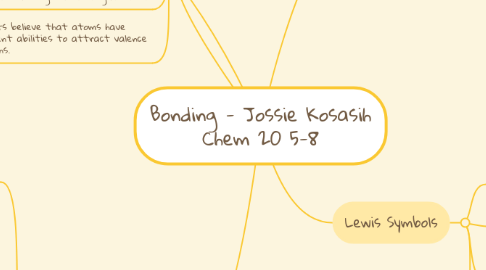
1. Valence Electrons & Orbitals
1.1. Valence Electrons
1.1.1. The electrons in the highest energy level of the atom
1.2. Orbitals
1.2.1. A region of space around an atom's nucleus in which an electron may exist
1.3. Quantum Mechanics
1.3.1. First energy level - has room for only one orbital with two electrons
1.3.2. Energy levels above the first have room for four orbitals (eight electrons total - octet rule)
1.3.3. An orbital can have 0-2 electrons total
1.3.4. Electrons will occupy any empty valence orbitals before forming electron pairs
1.4. Valence orbital
1.4.1. volumes of space that can be occupied by electrons in an atom's highest energy level.
1.4.2. the only orbitals we are concerned with when studying bonding.
2. Electronegativity
2.1. used to describe the relative ability of an atom to attract a pair of bonding electrons in its valence level.
2.2. determine the type of bond formed between atoms
2.3. Metals tend to have low electronegativities, while nonmetals tend to have high electronegativities.
2.4. Chemists believe that atoms have different abilities to attract valence electrons.
3. Types of Bonds
3.1. Ionic bonding
3.1.1. the attraction that results from a positive ion (metal) and a negative ion (nonmetal)
3.1.2. the electronegativity of one atom is stronger than the other
3.1.3. An electron transfer occurs and both positive ions (cations) and negative ions (anions) are formed.
3.2. Molecular bodning
3.2.1. the attraction of 2 nuclei for a shared pair of bonding electrons (a nonmetal and a nonmetal)
3.2.2. the electronegativities of both atoms are relatively high
3.2.3. the pair of bonding electrons will be shared between the two atoms
3.2.4. Single, double, & triple bonds
3.2.4.1. single
3.2.4.1.1. one pair of electrons is shared between two atoms.
3.2.4.2. double
3.2.4.2.1. two pairs of electrons are shared between two atoms.
3.2.4.3. triple
3.2.4.3.1. three pairs of electrons are shared between two atoms.
3.3. Metallic bonding
3.3.1. metal & metal
3.3.2. both colliding atoms have low electronegativities
3.3.3. the atoms can share valence electrons, but no actual chemical reaction takes place
3.3.4. valence electrons are not held strongly by their atoms & vacant valence orbitals
4. Bonding Theory
4.1. A Bond
4.1.1. the electrostatic force of attraction between two particles (atoms, ions or molecules)
4.1.2. When two atoms collide, they bond.
4.2. History
4.2.1. Edward Frankland (1852)
4.2.1.1. stated that each element has a fixed bonding capacity.
4.2.2. Friederich Kekulé
4.2.2.1. later extended this theory, stating that a bond is a dash between bonding atoms (structural formula)
4.2.3. Jacobus van't Hoff and Joseph Le Bel
4.2.3.1. extended them to three dimensions (3-D)
4.2.3.2. revised the existing theory to explain the ability of substances to change light
4.2.4. Richard Abegg
4.2.4.1. the first to suggest that bonding capacity was linked to an atom's electrons.
4.2.5. Gilbert Lewis
4.2.5.1. combined chemical formulas, the concept of valence, and the concept of stable electron numbers for atoms
4.2.5.2. He proposed that atoms could achieve stable electron arrangements by sharing electrons as well as by transferring them.
